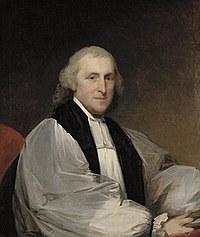William White (bishop of Pennsylvania): Difference between revisions
No edit summary |
|||
| Line 12: | Line 12: | ||
* [[William Markham (archbishop)|The Most Reverend William Markham]], 77th [[Archbishop of York]] |
* [[William Markham (archbishop)|The Most Reverend William Markham]], 77th [[Archbishop of York]] |
||
* [[Charles Moss|The Right Reverend Charles Moss]], [[Bishop of Bath and Wells]] |
* [[Charles Moss|The Right Reverend Charles Moss]], [[Bishop of Bath and Wells]] |
||
William White was the [[Succession of Bishops of the Episcopal Church in the United States|2nd]] [[bishop]] consecrated in the [[Episcopal Church in the United States of America|Episcopal Church]]. |
|||
===See also=== |
===See also=== |
||
Revision as of 22:15, 27 June 2006

The Most Reverend William White (1748 – July 17, 1836) was the first and fourth Presiding Bishop of the Episcopal Church, USA (1789; 1795-1836), the first Bishop of the Diocese of Pennsylvania (1787-1836, and the second United States Senate Chaplain (appointed December 9, 1790).
History
Born in Philadelphia, White traveled to England in 1770 in order to be ordained as a priest, and returned on two occasions: once in 1772 and again in 1787, when he was consecrated bishop by the Archbishop of Canterbury, the Archbishop of York, the Bishop of Bath and Wells, and the Bishop of Peterborough. Rector of St. Peter's and of Christ Church for 57 years, White also served as Chaplain of the Continental Congress from 1777 to 1789, and subsequently as Chaplain of the Senate. In 1785 he founded The Episcopal Academy, to educate the sons of Philadelphia's Episcopalian residents to become to leaders in society.
He was married to Elizabeth Leigh, who came from a landed Virginia family. White's younger sister Mary was married to Robert Morris, who was known as the "Financier of the Revolution" for securing funding for the colonial cause. White's reputation grew during the outbreaks of yellow fever in Philadelphia throughout the 1790s, because he remained to tend the ill when many other wealthy inhabitants fled the city. His home at 309 Walnut Street in Philadelphia is today part of Independence National Historical Park. It is notable, in part, as one of the first houses to have an indoor "necessary," at a time when most privies were built outside of houses.
Consecrators
- The Most Reverend John Moore, 88th Archbishop of Canterbury
- The Most Reverend William Markham, 77th Archbishop of York
- The Right Reverend Charles Moss, Bishop of Bath and Wells
William White was the 2nd bishop consecrated in the Episcopal Church.
See also
External links
References
- The Episcopal Church Annual. Morehouse Publishing: New York, NY (2005).
